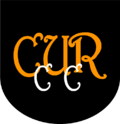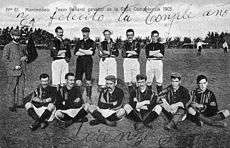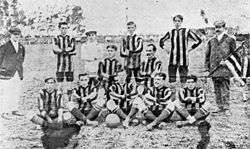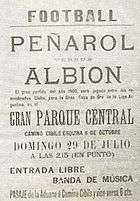Central Uruguay Railway Cricket Club
 | |||
| Full name | Central Uruguay Railway Cricket Club | ||
|---|---|---|---|
| Nickname(s) | Carboneros, Peñarol | ||
| Founded | 28 September 1891 | ||
| Dissolved | 22 January 1915 [lower-alpha 1] | ||
| Chairman | Percy Sedgfield | ||
|
| |||
Central Uruguay Railway Cricket Club is a defunct Uruguayan sports club, originally established as a cricket and football institution by British railway workers. The football section of the club is also a predecessor of current Club Atlético Peñarol.
History

.jpg)


Railway origins
By the end of 1899 the British company Central Uruguay Railway of Montevideo, that operated in Uruguay since 1878, acquired the lands located in the neighborhood of Villa Peñarol to establish its train repair shops there, moving them from Bella Vista. Those lands had been used for agriculture only and famous because of the best quality of its vineyards and fruits. One of the main achievements of the company was the establishment of a rural school in the town.
Due to the industrial activity, the village became populous. The sons of blonde Albion, who were part of the company, decided to found a sports centre that serve as recreation to people that lived around the workshops.[1]
Foundation
According to the club's foundation charter, the club was established on 28 September 1891 by the workers and employees of the Central Uruguay Railway Company of Montevideo, with the purpose of stimulating the practice of cricket, football and "other male sports" (literal from the Spanish). The first committee was formed by eight members: Mr. Hudson, Lucy, Moor, Davenport, Hopkins, Davies and Penny. They chose Mr. Frank Henderson as the first president of the club. The membership fee was established in $ 0,50.
One day later, the committee resolved to name the club "Central Uruguay Railway Cricket Club". That same day two members of the committee were chosen to write the rules, while two other members were chosen to search for a field to practice sports. The club also designated three members to take over advertising with the purpose of bringing new members to the institution.
The article I of club's statute stated that the club colors would be black and orange and that only workers of Central Railway would be admitted as members. Nevertheless, the committee could admit people outside the company but they were not allowed to vote in case of being accepted.[1]
At the beginning, all the CURCC presidents were managers of the CUR. In 1907 the company appointed W. Bayne as manager and sent him to Montevideo. When the CURCC executives told Bayne he was the new president of the institution, he did not accept the offer, alleging that the coaches damaged by the supporters led to significant costs. Other reason given by Bayne was the lack of players-workers.
CURCC took part of the recently created Primera División of Uruguay, along with Nacional, other team from Montevideo with whom CURCC had a strong rivalry. While CURCC represented the British immigrants to Uruguay and rail workers as well, the criollo people and university students felt empathy with Nacional.
The club took part of 13 editions of the domestic championship, winning it in five occasions between 1900 and 1911. CURCC also won the Copa de Competencia three times. Internationally, the squad won the Copa de Honor Cousenier twice.
C.A. Peñarol
Having been established as a cricket club, football began to be practised at CURCC in 1892, relegating other sports, such as cricket and rugby. The first football match played by CURCC was that same year versus a combined team of English High School. The match was won by CURCC 3-2. The club was also known as "Peñarol" due to the neighborhood where it had been established.
In 1912 a new committee was organized in order to review some of the CURCC statute books. The proposals were to give a bigger participation to non-railway employed members. Another suggestion was to rename the club "CURCC Peñarol". Due to financial problems and conflicts between the railway company workers and the managers, the CURCC transferred the football area to its members on 13 December 1913, as they had requested one month before. The football division kept the name "CURCC Peñarol" although on 12 March 1914 it changed its name to "Club Atlético Peñarol", which it has remained ever since.[2]
Since the secession, the CURCC focused on cricket exclusively until the club was dissolved in 1915.[3]
Rivalry

CURCC's first main rival was Albion, with which the club had the longest rivalry during late 19th century.[4]
Albion was the first team CURCC played a football match, more precisely on May 25, 1892. Albion defeated CURCC by 3-2. Nevertheless, CURCC achieved a long victory in the second game vs. Albion. Then it would be discovered that two of CURCC's members, Woosey an Sagehorn, were also founders of Albion. As a result, Albion expelled him.
By 1896 Albion was the strongest team of Uruguay, being defeated only once after 19 matches played. Between 1897 and 1898 CURCC played Albion 6 times, winning 2, and losing 3.
On March 22, 1901, Nacional' request to enter the Uruguayan Football Association was approved. Since then, the club would win many championships, becoming CURCC's (and its successor Peñarol) main rival.[5]
Symbols
Colors


In October 1829, the Rainhill Trials a competition honoring Queen Victoria was held in London. Several locomotives were exhibited in order to define which would run the Liverpool and Manchester Railway route. Although 10 locomotives were entered, only five would be tested for the competition. They were: Rocket, designed by George & Robert Stephenson, made in gold and black colors; Sans Pareil by Timothy Hackworth, Novelty built by Swedish John Ericsson, painted in blue and gold as the flag of Sweden; Perseverance, and Cycloped, built by Thomas Shaw Brandreth.
The Rocket was the only locomotive that completed the competition, therefore it was proclaimed winner. The Rocket had been painted in black (the color of coal that fueled the machine) and yellow (for King George IV). When Central Uruguay Railway began to operate in Uruguay, the club adopted the colors that identified the company.[6]
Uniform
Since the club was established, its colors have been dark yellow and black.[7] They were inspired in the Rocket locomotive that had been designed by George Stephenson in 1829.
Kit evolution
1891-96[8] |
1896-1910 |
1911-13[9] |
1914-15[10] |
Titles
Domestic
- Primera División (5):
- Copa de Competencia (7):
- 1901, 1902, 1904, 1905, 1907, 1909, 1910
- Copa de Honor (3):
- 1907, 1909, 1911
International
- 1909, 1911 [11]
See also
Notes
- ↑ The date of dissolution refers to the CURCC as a cricket institution, so the football section had separated in 1913 as the Club Atlético Peñarol.
References
- 1 2 Por la Verdad, by Alberto Mantrana Garín (also former president of C.A. Peñarol (1939), translated from Spanish
- ↑ "Línea de tiempo" - Peñarol official site
- ↑ "Historia del barrio Peñarol" on Revista Raíces, article by Emilio Tacconi (2009)
- ↑ "Albion Football Club: profetas del sport en Uruguay" on EF Deportes, 30 Jul 2014
- ↑ "La forja de la rivalidad clásica: Nacional-Peñarol en el Montevideo del 900" by Juan Carlos Luzuriaga
- ↑ "Historia de la marca Mitre" by Mario Lopes, 28 Jun 2014
- ↑ "La fundación de Peñarol" on PadreyDecano website
- ↑ "La noche inolvidable de Peñarol", El Observador
- ↑ Uniforme 1911-13
- ↑ Uniforme 1914-15
- ↑ Copa de Honor Cusenier at RSSSF
External links
 Media related to CURCC at Wikimedia Commons
Media related to CURCC at Wikimedia Commons- C.A. Peñarol official site (Spanish)